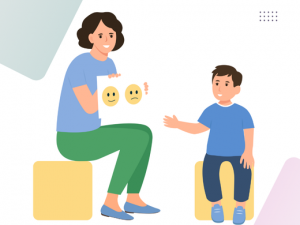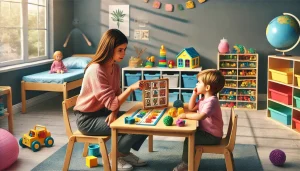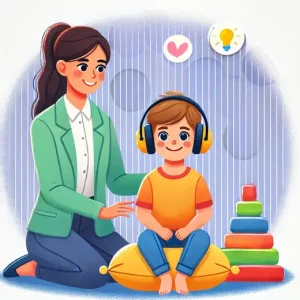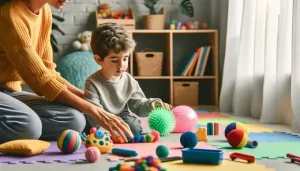Understanding and Improving Motor Skills in Autistic Children
By Rajini D
Last Updated: November 27, 2021
Among the most frequent disorders observed in children, Autism takes a major place. Autism spectrum disorder is characterized by deficits in social interaction, communication and repetitive behaviors. When motor dysfunction in Autistic children is discussed, the topic is mostly focused on stereotyped and repetitive movements such as hand flapping or body rocking. Along with them, nonfunctional arm wave and awkward hand-to-ear posture are also observed among infants with ASD as early as 12 months.
The repetitive motor movements and the commonly observed behaviors are the usual diagnostic criteria for ASD in children.
Also Read: Childhood Apraxia of Speech: Symptoms, Origins & Treatments
What are Motor Skills?
Motor skills are the movements and actions of the muscles in our body. Though our movements tend to look simple, they take a lot of skill. A motor skill is a learned ability to cause a predetermined movement outcome with maximum certainty. There are two types of motor skills, namely gross and fine motor skills.
Gross Motor Skills
Gross motor skills can be understood as large movements made using arms, hands, legs, feet or entire body, such as crawling, walking, running, throwing a ball, and jumping, etc.
Fine Motor Skills
Fine motor skills can be understood as smaller actions made using fingers, toes, lips, tongue etc., such as picking things, writing, drawing, tasting etc.
Read more Enhancing Kids Writing: Key Fine Motor Skills Development
As Autism is a neurological condition and doesn’t have any specified physical characteristics, this concept of motor development in Autistic children has been in focus. But the differences in brain functioning in Autistic children rather than the normal ones are not easy to detect.
Autistic children have varying degrees of difficulty with fine and gross motor skills. Studies say that kids with Autism could be six months behind in gross motor skills and a year behind in fine motor skills when compared with normal children of their age. These difficulties exist due to the neurological conditions and their challenges with sensory processing. These motor difficulties are not same in all the Autistic children.
While some face difficulty with gross motor skills, some face more pronounced difficulty with fine motor skills and some have difficulty facing both the problems. Tests showed that 83 percent of children with Autism spectrum disorder were below average in motor skills.

Comparative Table of Motor Skills Development
| Age Range | Typical Development Milestones | Observed Milestones in Children with Autism |
|---|---|---|
| 6 Months | Rolls over both ways. | May have difficulty with rolling over. |
| Sits with minimal support. | May require additional support to sit. | |
| 12 Months | Crawls forward on belly. | Crawling may be delayed or atypical. |
| Stands with assistance. | May struggle with standing, even with support. | |
| 18 Months | Walks independently. | Walking may be delayed; may walk on tiptoes. |
| Picks up toys with pincer grasp. | May have difficulty with fine motor skills like picking up toys. | |
| 2 Years | Runs without falling. | Running may be awkward or delayed. |
| Begins to kick a ball. | May not show interest or struggle with kicking a ball. | |
| 3 Years | Climbs well on furniture and playground equipment. | Climbing skills may be less developed; may show fear or disinterest in climbing. |
| Copies circle shapes with pencil or crayon. | Struggles with imitation of shapes; may have poor grip. | |
| 4 Years | Catches a bounced ball most of the time. | Difficulty with catching or throwing balls. |
| Uses scissors to cut simple shapes. | May struggle with using scissors or other fine motor tasks. | |
| 5 Years | Hops and stands on one foot up to 10 seconds. | Balance and coordination challenges may make hopping or standing on one foot difficult. |
| Draws person with at least 6 body parts. | Drawing skills may be delayed; may not depict detailed figures. |
Difficulties of children with ASD
Actually, there had been confusion in the assessment of the reason for Motor impairments of Autistic children, whether it is due to ASD or if it runs in the families. The researchers of Washington University school of Medicine in St.Louis have found that kids with Autism spectrum disorders exhibit significantly more impairment in the motor related areas than their siblings who don’t have the disorder. These motor-related problems are common in Autism children and they contribute to social problems during childhood because kids with Autism can’t do things that other kids can do.
Kids having difficulty with these motor skills might have trouble even with simple things like brushing their teeth, pulling a zip or buttoning their shirts. Such kids need to have an aid to help them even at school. Having difficulty with little things makes everything tough for them and has a lot of impact on their whole well-being. The children who realize their inefficiency may develop low self-esteem, so even if they have delays only in the motor skills, there is a lot of impact on their well-being into adulthood, says a Hilton, assistant professor in occupational therapy and an instructor in psychiatry.
OT Intervention Helps
The daily challenges faced by children with Autism Spectrum disorder relate to the areas of social interaction, communication, sensory processing and cognitive difficulties, motor planning, and coordination skills. The lower motor proficiency scores in children with an Autism Spectrum disorder, the greater will be the degree of social impairment and severity of the order. It is really necessary to make them work with an occupational therapist to improve in these areas. Occupational therapists are trained to determine why there is a delay in fine motor skills. It can be due to motor planning, posture and low tone, visual motor integration skills, or sensory processing difficulties. Occupational therapists also offer interventions addressing individual’s fine motor skills through activities targeting all these skill areas. Working on these areas, improves the fine motor skills including dressing, self-care, grooming, and feeding tasks, along with writing and drawing.
Learn more about on Engaging Home-Based Occupational Therapy Activities for Children with Autism
Special Treatment Plans
After a professional identifies a child having difficulties with motor skills development, a treatment plan is developed accordingly, to meet their needs. Parents should be familiar with the plan designed for their kids and should take an active role in assisting them with those therapies, intended for specific development plan.
Strategies that Help

The therapy sessions help your child to improve their skills. In order to develop and strengthen your child’s fine motor ability, occupational therapists develop specific activities and strategies. Parents at home can also make this possible by making the Autistic kids do some activities like the following.
- Making the child play with slime or a similar resistive structure, and pull apart and squeeze it
- Blasting the bubbles on a bubble wrap
- Playing with a squeeze toy
- Peeling stickers
- Using a hole punch
- Cut out simple shapes or along a line
- Putting coins in a piggy bank box
- Looking for hidden objects in play dough, putty or clay
- Making them use broken crayons to practice gripping
- Building letters using wikki stick or pipe cleaners
- Making the child write in sand, dirt or other tactile material
- Lacing beads/blocks of various sizes onto strip or pipe cleaners
- Using a squeeze bottle to water the plants
- Making to pull out the hidden objects like some marbles from sand
- Making the child to put different materials in different containers
- Use magnet tiles or construction blocks to pull apart and piece together
- Use clothespins or tongs to pick up small manipulatives to sort
- Making them pull Velcro strips using them with some simple puzzles
Such sort of activities involving the motor skills helps them to improve in specific areas. It is necessary to involve them in play activities and to make them try some what difficult activities. We at Wellness hub work to facilitate the kids with Autism to meet their basic needs. We help in overcoming their problems with social interaction, communication, and behavioral challenges. Book an appointment to meet our group of experienced professionals, today.
Read more about on Prewriting Skills in Children: Foundations of Writing
Emerging Therapies and Technological Aids
One groundbreaking area is the use of technology-assisted interventions. Virtual reality (VR), for instance, has emerged as a powerful tool in engaging children with autism in motor skill improvement exercises. VR environments can be tailored to each child’s preferences and developmental level, making the learning process more enjoyable and less intimidating. These interactive sessions not only improve motor skills but also enhance attention span and engagement, crucial factors for children on the autism spectrum.
Effectiveness of Sensory Integration Therapy
Sensory integration therapy has also received attention for its role in improving motor skills. By addressing sensory processing issues, this therapy helps children with autism better integrate sensory input, leading to improvements in coordination and motor planning. Recent findings suggest that integrating sensory therapy with traditional motor skills training can accelerate progress, offering a holistic approach to development.
To know more about read our article on Parents Guide to Sensory Integration and Occupational Therapy
The Role of Occupational Therapy
Occupational therapy (OT) continues to be pivotal in developing fine and gross motor skills. Tailored OT interventions focus on everyday tasks, from dressing to handwriting, ensuring that improvements in motor skills translate into real-world benefits. Studies underscore the value of early, consistent OT, highlighting its impact on enhancing life skills and independence.
Innovative Practices in OT
Innovative OT practices, such as the use of adaptive tools and modified environments, have proven effective in supporting motor skills development. These adaptations encourage autonomous participation in activities, fostering a sense of achievement and boosting self-esteem. The emphasis on creativity and adaptability in therapy sessions reflects a deeper understanding of the varied needs of autistic children.
Interactive Activities
Incorporating interactive activities into the daily routine of children with autism is not just about enhancing their motor skills – it’s about opening doors to a world of social interaction and joyous discovery.
Group Dance and Movement Games
Dance is a beautiful way to express oneself and a fantastic method for improving coordination and gross motor skills. Organizing group dance sessions where children can follow simple routines or free dance to their favorite tunes creates a lively environment. It’s not just about the steps but the smiles, the laughter, and the shared joy of movement that make this activity a hit.
Obstacle Courses
Creating obstacle courses with cushions, tunnels, and hoops encourages children to crawl, jump, and balance, enhancing their gross motor skills. Turn it into a team activity where children can cheer each other on, fostering a sense of belonging and cooperation. This activity is not only fun but also builds problem-solving skills and confidence.
Interactive Ball Games
Ball games are versatile and can be adapted to suit various skill levels. Simple activities like rolling a ball back and forth can improve hand-eye coordination. For more advanced skills, playing catch or organizing a simple soccer game can be both challenging and rewarding. These games encourage turn-taking and teamwork, essential components of social interaction.
Craft and Build Sessions
Fine motor skills get a boost during craft sessions. Activities like threading beads, using playdough, or building with blocks can be done in small groups, where children can share materials and ideas. This setting not only nurtures creativity but also promotes sharing and communication among peers.
Garden Treasure Hunts
Organize a treasure hunt in a garden or a playground, where children have to find objects hidden in different locations. This activity encourages exploration and physical activity, requiring children to walk, reach, and dig. Working in teams or pairs, children learn the value of teamwork and the excitement of discovery.
Yoga for Kids
Yoga can be a calming and bonding experience, especially when done in a group. Simple poses that mimic animals or nature can captivate children’s imaginations while improving their balance and flexibility. Incorporating storytelling into yoga sessions makes this activity not only beneficial for motor skills but also a rich sensory experience.
Sensory Stations
Set up stations with different sensory activities, such as sand play, water tables, or foam areas. These stations can be platforms for children to explore textures, practice scooping, pouring, or picking up objects, refining both gross and fine motor skills. Engaging in these activities alongside peers allows for social learning and interaction in a non-competitive setting.
Activity Benefits Table
| Interactive Activity | Fine Motor Skills | Gross Motor Skills | Social Skills | Emotional Well-being |
|---|---|---|---|---|
| Group Dance and Movement Games | Enhances coordination and balance. | Promotes teamwork and communication. | Boosts confidence and joy through group participation. | |
| Obstacle Courses | Improves agility, balance, and spatial awareness. | Encourages cooperation and peer support. | Enhances self-esteem through achievement of goals. | |
| Interactive Ball Games | Develops hand-eye coordination and precision. | Aids in building strength and coordination. | Fosters turn-taking, sharing, and teamwork. | Supports emotional regulation through play. |
| Craft and Build Sessions | Enhances dexterity and control in hand movements. | Encourages sharing ideas and collaborative creativity. | Promotes a sense of accomplishment and self-expression. | |
| Garden Treasure Hunts | Promotes fine motor precision in searching and collecting. | Encourages gross motor movement through exploration. | Builds social interaction through shared discovery. | Fosters a sense of adventure and achievement. |
| Yoga for Kids | Supports fine muscle control in poses. | Promotes body awareness and balance. | Aids in stress relief and emotional balance. | |
| Sensory Stations | Encourages tactile exploration and manipulation. | Supports gross motor skills through interactive play. | Provides calming sensory input for emotional regulation. |
Also Read: Home based Speech Therapy Activities – Fun with Numbers
Conclusion:
In closing, it’s clear that helping kids with autism improve their motor skills goes hand in hand with boosting their confidence and ability to make friends. The fun and engaging activities we’ve talked about are more than just exercises; they’re a way to help these kids feel good about themselves and connect with others. At Wellness Hub, we’re all about making this happen. We offer special programs designed just for kids with autism, focusing on everything from moving better to playing and interacting with others.
We’re here to support these kids and their families every step of the way. At Wellness Hub, our goal is to create a place where kids can learn, grow, and have fun all at the same time. So, let’s work together to give them all the help they need to thrive.
Know more about on What are the therapies offered to Autistic patients? | Therapies of Autism
Frequently Asked Questions:
1. What are motor skills in autistic children?
Motor skills involve the movements and actions of muscles. In autistic children, these can include both fine (small movements like writing) and gross (larger movements like running) motor skills, which may develop differently.
2. How can interactive activities help autistic children?
Interactive activities boost motor skills, social interaction, and emotional well-being in autistic children by making learning fun and engaging, encouraging participation and cooperation with peers.
3. What role does Wellness Hub play in supporting autistic children?
Wellness Hub offers specialized programs focused on improving motor skills and social interaction in children with autism, utilizing a range of fun, engaging activities tailored to each child’s needs.
4. Can occupational therapy benefit children with autism?
Yes, occupational therapy is beneficial for children with autism as it focuses on improving fine and gross motor skills, sensory integration, and daily living skills, contributing to overall development and independence.
5. What are some simple activities to improve motor skills at home?
Simple home activities include playing with playdough, threading beads, practicing writing in sand, and engaging in catch or ball games to improve both fine and gross motor skills in a fun, stress-free way.
6. How do motor skills affect social interactions in autistic children?
Motor skills directly impact social interactions as difficulties in these areas can hinder participation in common play and learning activities, affecting communication and social bonding with peers.
7. What innovative therapies are available for motor skills development?
Innovative therapies include sensory integration therapy, technology-assisted interventions like virtual reality, and personalized occupational therapy sessions focusing on specific motor skill enhancement.
8. How often should autistic children engage in motor skills activities?
Consistency is key. Engaging in motor skills activities daily, even for short periods, can significantly improve outcomes. Tailored advice from therapists at Wellness Hub can help set the right frequency based on individual needs.
9. Can technology aid in the development of motor skills for autistic children?
Yes, technology like apps and virtual reality can make learning more interactive and engaging for autistic children, aiding in the development of both fine and gross motor skills in a fun and effective way.
10. What signs indicate a child with autism might need help with motor skills?
Signs include delays in reaching developmental milestones like crawling or walking, difficulty with tasks like writing or buttoning clothes, and challenges in coordinating movements during play.
About the Author:
Rajini, Speech-Language Pathologist:
Rajini is a dedicated Speech-Language Pathologist with a focus on developmental speech and language disorders in children and rehabilitation in adults. With a passion for helping each individual find their voice, Rajini brings a wealth of experience and a heartfelt approach to therapy. At Wellness Hub, she’s part of a team that values innovation, compassion, and results-driven practices.
Book your Free Consultation Today
Parent/Caregiver Info:
Client’s Details:
* Error Message








